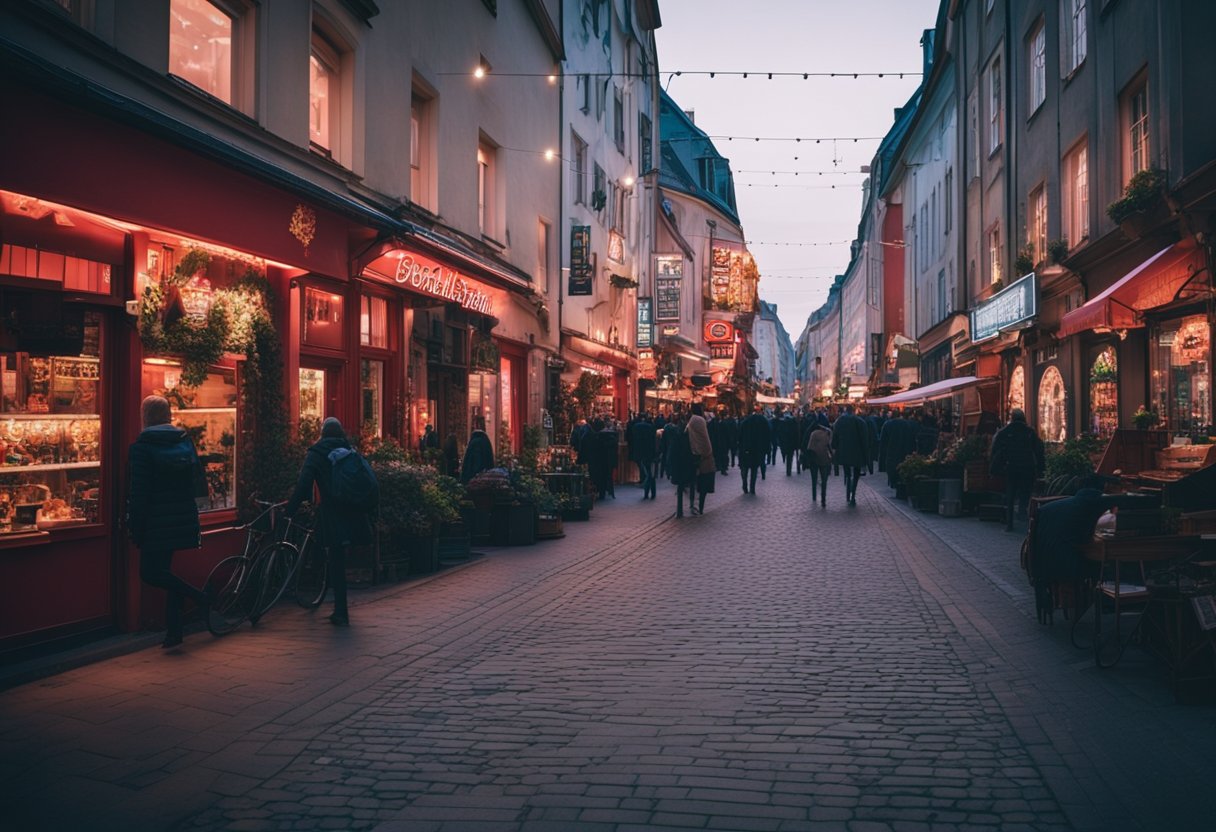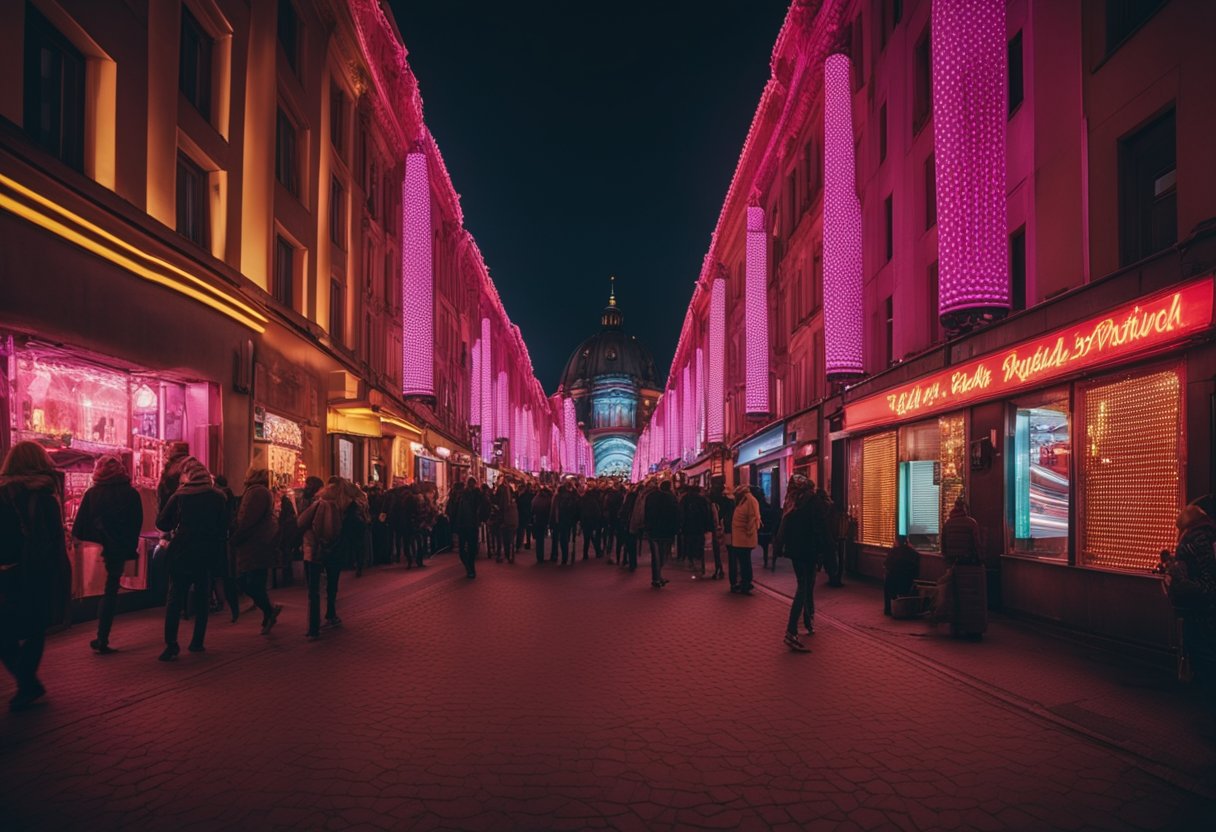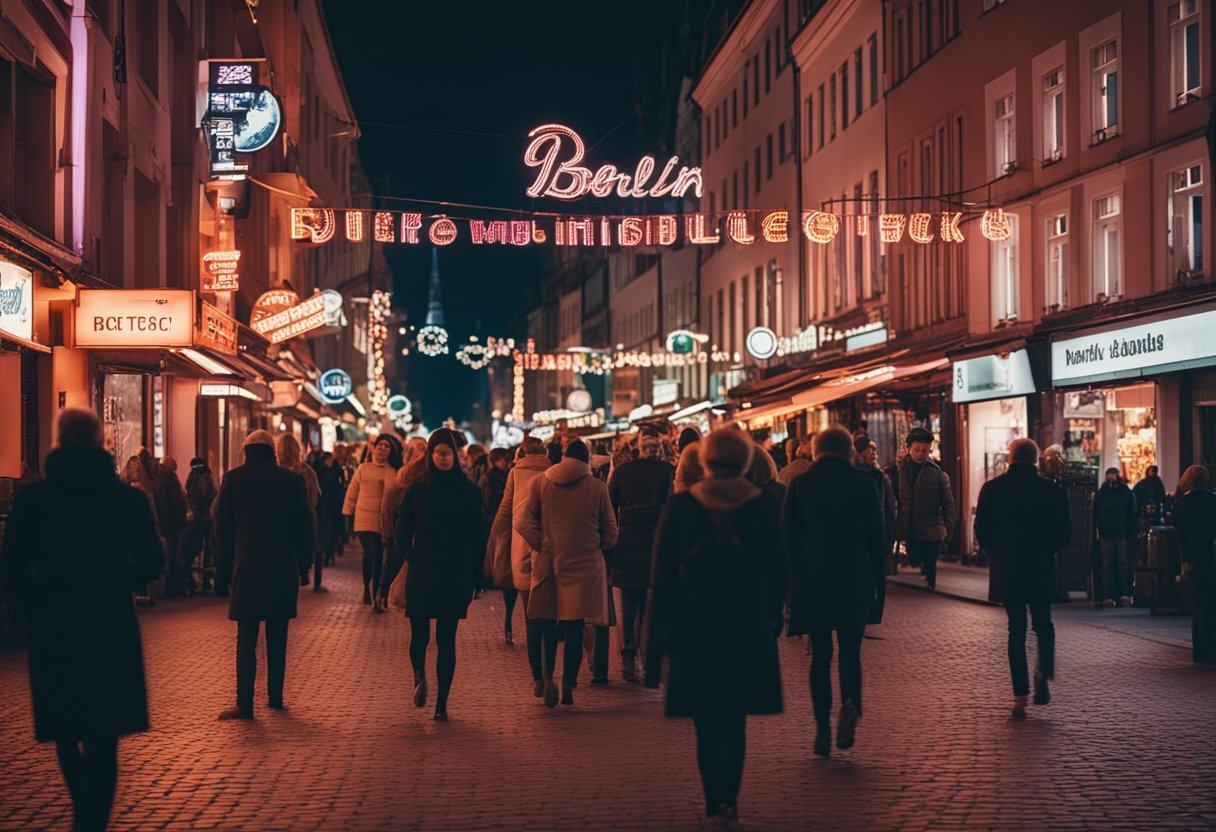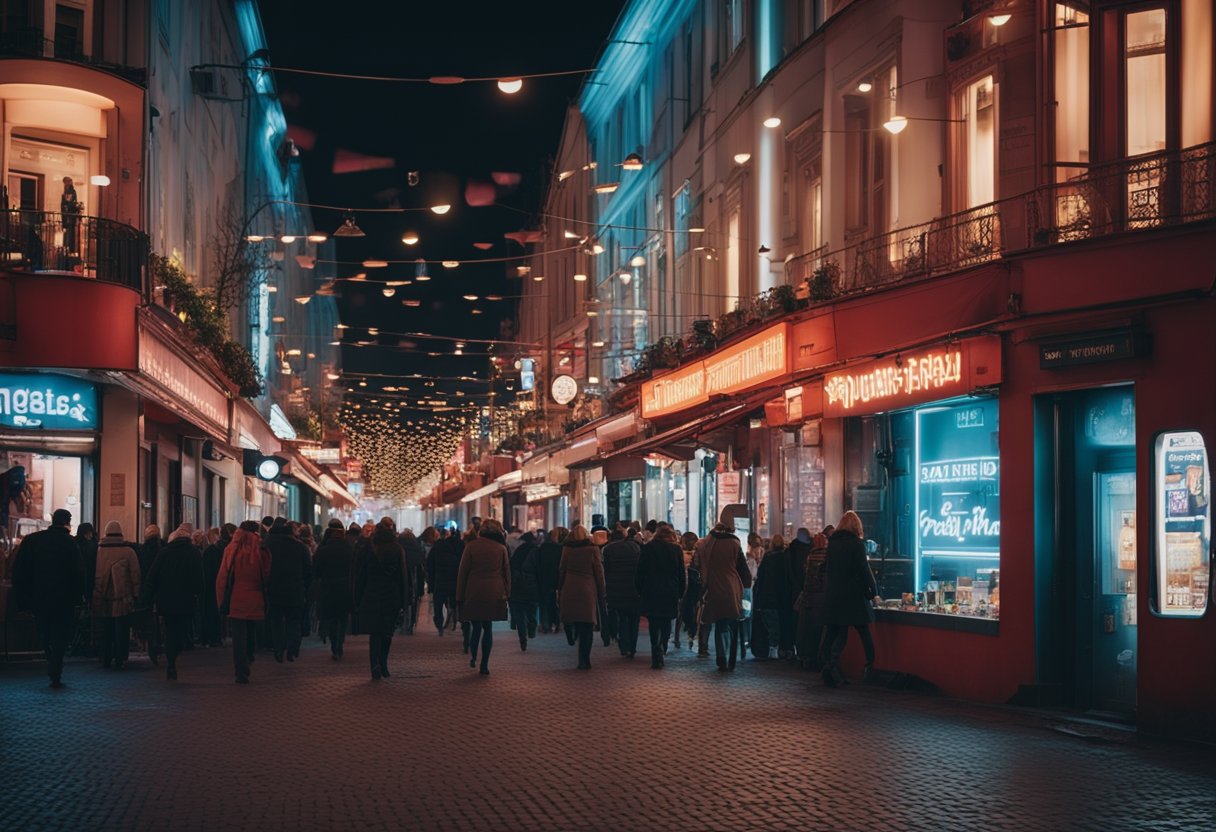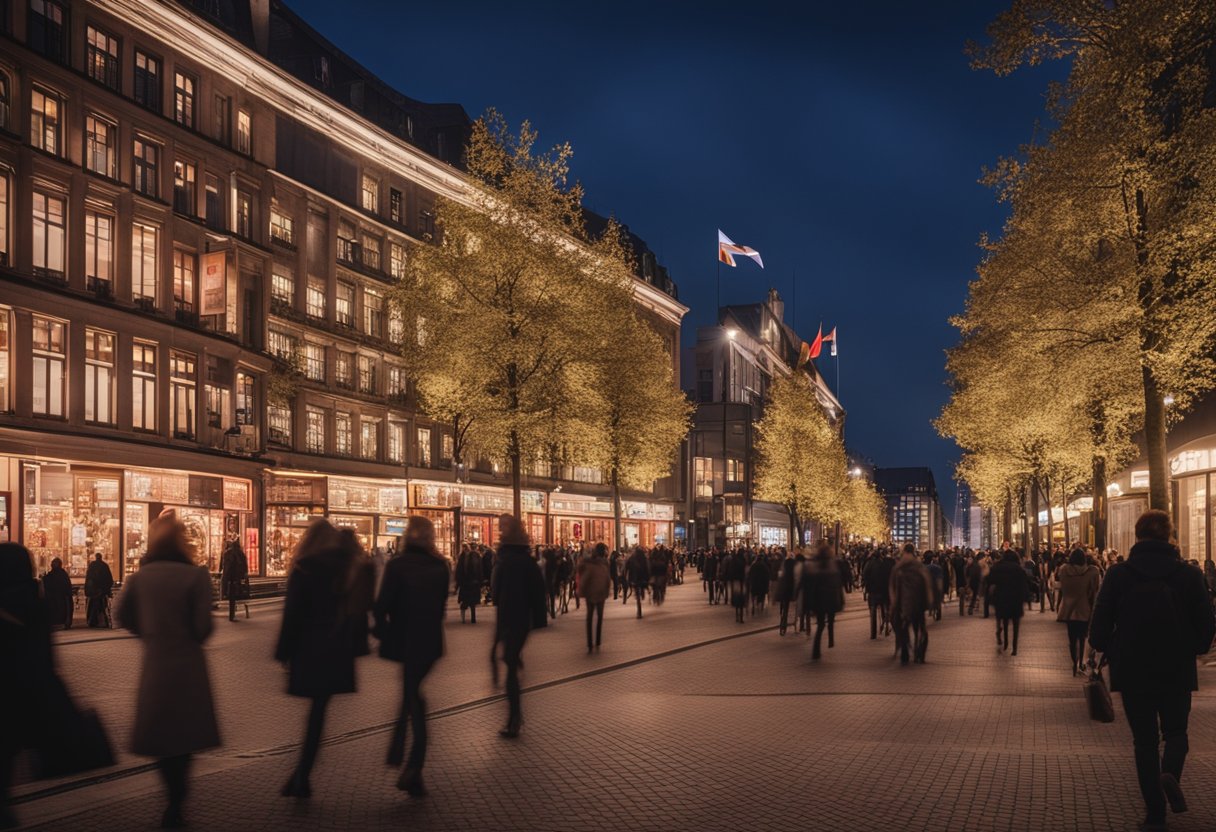Berlin, Germany’s vibrant capital, is known for its rich history and diverse nightlife. Within this multifaceted city lies the red-light districts in Berlin situated in the Mitte neighborhood, specifically around Oranienburger Straße.
This area, legal and regulated for sex work, provides various adult entertainment options, blending seamlessly with the district’s bars and restaurants contributing to the city’s energetic nightlife scene.
Legality and openness characterize Germany’s approach to prostitution, and Berlin exemplifies this regulatory environment with its well-established red light district.
The city, home to a myriad of cultural institutions such as ballet companies and museums including Madame Tussauds, contrasts sharply with the more discreet nocturnal operations of the red light areas.
Beyond its nightlife and adult entertainment, Berlin offers a variety of experiences ranging from culinary delights at places like KFC and McDonald’s, to academic pursuits at educational institutions like ESMT Berlin.
The city also hosts events such as Oktoberfest, catering to both local and international visitors. For travelers, convenient transportation options are available, including train services connecting cities like Bremen and Stuttgart to Berlin, simplifying travel across Germany.
Historical Overview
The red-light district in Berlin has its roots deeply embedded in the city’s history, evolving through tumultuous periods and reflecting societal changes over time.
Weimar Republic Era
During the Weimar Republic, Berlin established itself as the German capital renowned for its liberal atmosphere and vibrant nightlife.
The period was marked by an unprecedented liberalization of social attitudes, particularly towards sexuality. This liberality contributed to the flourishing of various entertainment venues, some of which were located in what is now known as the red light district in Berlin.
Post Berlin Wall
After the fall of the Berlin Wall, the city underwent major reconstruction and reunification challenges.
As the capital of Germany once again, Berlin experienced a surge in the gentrification of many neighborhoods, including the areas known for sex work. However, the red light district persisted, adapting to new legal and social realities, and remains a facet of modern Berlin’s unique cultural landscape.
Legal Framework
In Berlin, Germany, the red-light district operates within a clearly defined legal framework that governs prostitution. This framework is centered on ensuring legality, safety, and regulation.
Prostitution Laws
Prostitution is a legal and regulated industry in Germany. The Prostitution Act (ProstG) was passed in 2002, which decriminalized the profession and recognized sex workers’ rights.
Under this act, prostitution is viewed as a legitimate job, allowing individuals to voluntarily engage in sex work, enter into formal labor contracts, and claim social security benefits like any other employee.
Regulations and Safety
The German government’s approach to regulate the sex industry includes mandatory health checks for sex workers and strict zoning laws.
For safety, it is obligatory for condoms to be used during intercourse; the law is rigorously enforced to ensure the health and safety of both sex workers and clients in the red-light districts.
Moreover, areas like Oranienburger Straße are subject to local police monitoring to maintain order and safeguard all parties involved.
Major Red-Light Districts in Berlin
Berlin hosts several areas known for their red-light activities, offering a mix of nightlife and adult entertainment. The city’s most notable red-light precincts are Kurfürstenstrasse, Potsdamer Strasse, and Schoeneberg, each with distinct characteristics and offerings.
Kurfürstenstrasse
Kurfürstenstrasse is one of the primary areas in Berlin where sex workers are known to operate. It is notorious for street-based sex work, particularly after dusk. Despite the area’s gritty reputation, it remains a well-known part of Berlin’s adult entertainment landscape.
Potsdamer Strasse
Once infamous for its plethora of brothels and adult entertainment venues, Potsdamer Strasse has undergone significant changes. While traces of its red-light roots remain, the district is evolving, now dotted with art galleries and upscale eateries amid its remaining nighttime establishments.
Schoeneberg
Schoeneberg is traditionally recognized for its accepting attitude and LGBTQ-friendly environment. Also part of Berlin’s red light district, it houses bars and clubs where adult entertainment is readily accessible, catering to a diverse clientele seeking various evening pursuits.
Berlin’s Nightlife Scene
Berlin is renowned for its vivacious nightlife, which includes a variety of bars, clubs, and adult entertainment venues. The city’s liberal attitude towards the night economy allows for a diverse range of nocturnal activities.
Bars and Clubs
Berlin’s bar scene offers an eclectic array of options ranging from laid-back watering holes to high-energy dance clubs.
Many bars and clubs provide patrons with a spectrum of musical genres and atmospheres. For instance, visitors looking for a trendy vibe might head to areas like Kreuzberg or Friedrichshain where the nightlife is particularly dynamic.
Brothel and Escort Services
Regarding adult entertainment, Berlin’s legal framework supports brothel and escort services within the city.
The red light district—significantly noted to be located around Oranienburger Straße—features a number of legal venues where sex trade is regulated and safety measures are implemented for both workers and clients. Escort services also operate legally, with many agencies offering a range of companionship options across Berlin.
Visitor Information
When planning a visit to the red light district in Berlin, it’s important for visitors, including tourists and families, to consider safety measures and understand the expected behavior in the area. This section will provide tourists with essential information on how to navigate the district responsibly.
Safety and Etiquette for Tourists
The red light district is located near Oranienburger Straße, which can be accessed easily by public transport or on foot from central locations such as the H10 Berlin Ku’damm or Myers Hotel Berlin.
Tourists should be aware that while the district is regulated, maintaining vigilance, especially at night, is advisable for personal safety. Taking photographs of sex workers without consent is considered disrespectful and is highly discouraged.
Families planning to visit nearby attractions, such as Madame Tussauds Berlin, may wish to avoid the district to maintain a family-friendly itinerary, as it is an adult-oriented area.
Parents should be mindful that the district is not suitable for children due to the explicit nature of the businesses operated there. Traveling in groups is recommended, and visitors should keep personal belongings secure to avoid potential pickpocketing incidents.
Guided Tours and Experiences
Several guided tours offer experiences within Berlin’s red light district for those interested in the history and culture of the area. These tours provide a deeper understanding of the district’s role in Berlin’s social fabric while ensuring the safety and comfort of participants.
Tour package information can often be found online, and it is suggested to book guided tours in advance, especially during peak tourist seasons like Oktoberfest in Berlin. Some tours may also provide insights into Berlin’s nightlife, covering aspects other than the adult entertainment industry, such as the city’s rich history and contemporary culture.
For visitors seeking further experiences in Berlin, the city is known for its diverse offerings, including ESMT Berlin and various dining options like KFC Berlin Germany and McDonald’s Berlin Germany. Berlin has amply demonstrated its vibrant and eclectic character through these various attractions.
Please remember to check the local laws and customs surrounding areas such as the red light district Berlin Germany, especially if you are visiting from outside the area, to ensure a respectful and enjoyable visit.
Cultural Influence
The red-light district in Berlin, Germany, has exerted a significant cultural influence, particularly on the city’s art and music scene. Not only has it attracted artists and musicians, but it has also inspired a variety of creative works and cultural expressions.
Influence on Art and Music
Berlin’s red-light district is intrinsically linked to the city’s artistic heritage, having been a melting pot for various forms of expression. David Bowie, an icon of music, spent a considerable time in Berlin and the ambience of the district, along with the city’s broader cultural landscape, influenced his Berlin Trilogy of albums.
The area’s gritty yet vibrant character has been a catalyst for subversive and avant-garde art movements, resonating with Bowie’s experimental approach to music and persona. Similarly, the locale continues to inspire contemporary artists, who use its edginess as a backdrop for innovative art exhibitions and performances.
Comparative Analysis with Amsterdam
When compared to Amsterdam’s well-known De Wallen district, Berlin’s red-light district presents a contrasting narrative. Amsterdam’s red-light area is a major tourist attraction, known for its distinct historical architecture and legal transparency.
While Berlin’s district lacks the high-profile reputation of Amsterdam’s, it shares a similarly legalized status of sex work, albeit with a more subdued presence within city tourism. The comparative tolerance in both cities has allowed the red-light districts to become somewhat normalized components of their urban identities.
Despite this, they each maintain unique cultural footprints, with Berlin’s district often recognized for its convergence with the punk rock scene and the underground art world.
Berlin’s district, due to its lower profile, might not be as immediately associated with the city’s cultural scene as Amsterdam’s, but it has undeniably contributed to the artistic and musical fabric of Berlin.
Media and Representation
In exploring the topic of the red-light district in Berlin, Germany, various forms of media provide different dimensions to the understanding of this locale.
Stock photos often depict the Red Light District with neon lights and night-time imagery, conveying the area’s lively nocturnal atmosphere. However, these images may lack context and should be viewed as an introductory visual guide rather than a comprehensive representation.
Videos serve as dynamic portrayals of the district, often capturing the candid street scenes and the vibrant nightlife that is characteristic of the area.
They can offer a glimpse into the day-to-day activities and interactions, though the content can vary widely in terms of the angle and depth of information provided.
360° panoramic images and panoramic images enable a more immersive experience, allowing the viewer to virtually explore the streets and surroundings.
This format gives a spatial sense of the red-light district, including aspects like its proximity to notable landmarks such as the H10 Berlin Ku’damm and Madame Tussauds Berlin.
Vectors serve a different purpose; these are typically stylized depictions that can be used in informative material or online content. The vectors could represent maps or iconic elements of the district, useful for orientation or conceptual illustrations.
To ensure a comprehensive representation, it’s important to recognize that while the district is an infamous part of Berlin’s urban landscape, it is just one aspect of a multifaceted city that includes sites such as the ESMT Berlin and various international dining options like KFC and McDonald’s.
The district’s representation in media should always be considered in the context of the broader cityscape of Berlin, which is rich in culture and history.
Frequently Asked Questions
The Berlin red light district, a topic of curiosity and inquiry for many visitors, is an area known for adult entertainment. These frequently asked questions will provide information on accommodation, navigation, and context regarding this locale in Berlin.
What are some recommended hotels in the Berlin red light district?
Visitors looking for accommodation near the Berlin red light district might consider staying at H10 Berlin Ku’damm, which is known for its proximity to the area and its quality service.
Can you provide a map highlighting the Berlin red light district?
While a specific map cannot be provided here, maps highlighting the area can typically be found online or at local tourist information centers in Berlin, indicating areas like Oranienburger Straße.
How prominent is the Berlin red light district compared to others in Germany?
The red light district in Berlin is less centralized than the famous Reeperbahn in Hamburg but still offers a range of activities and establishments in the nightlife sector.
What are the main streets known for red light activities in Berlin?
Oranienburger Straße in Berlin’s Mitte district is noted for being an area where nightlife and red light activities coexist, though it’s not an official red light district.
What is the historical background of Berlin’s red light district?
Berlin’s approach to adult entertainment has evolved over the decades, reflecting broader social and legal attitudes towards such activities in Germany.
How can I get directions to the nearest red light district when in Berlin?
To find your way to areas known for adult entertainment in Berlin, like Oranienburger Straße, use reliable navigation apps or ask for directions at your hotel.
